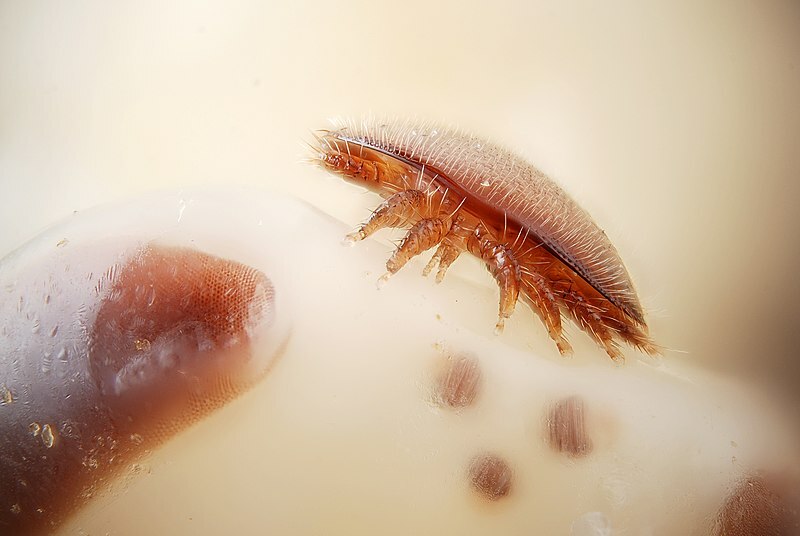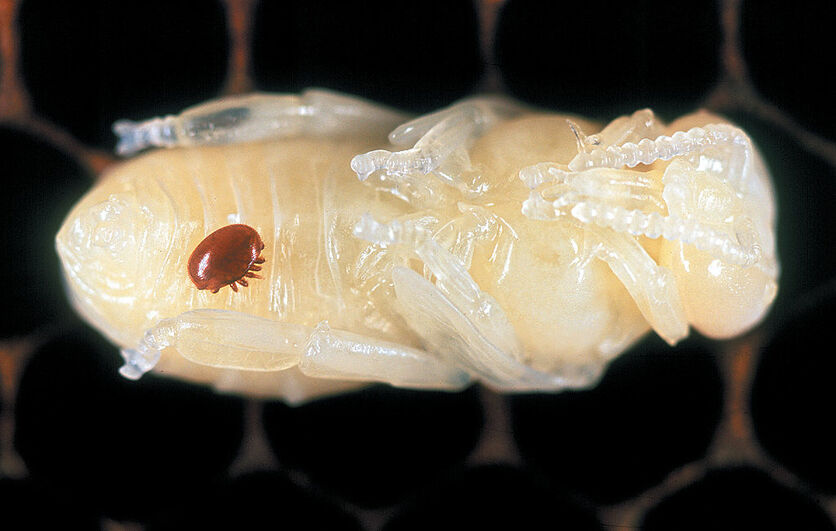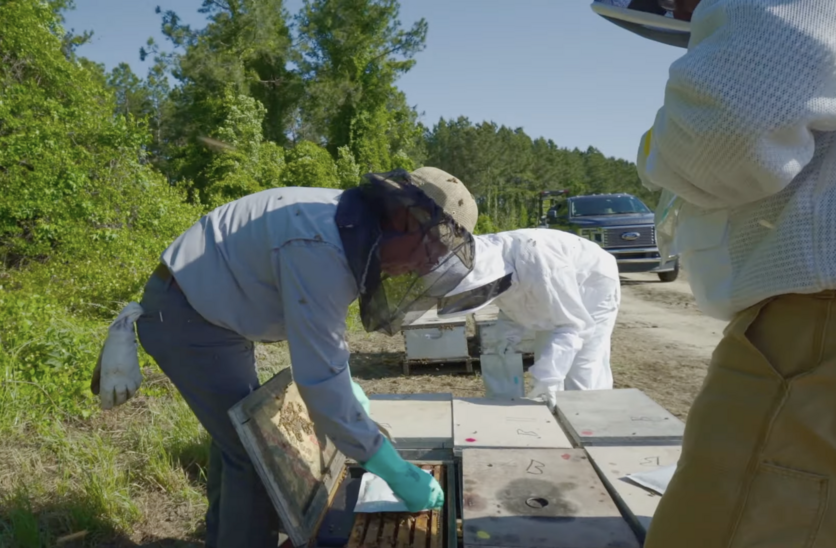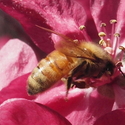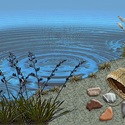The varroa mite is a tiny but destructive pest responsible for the deaths of many honey bee colonies in Aotearoa New Zealand and around the world. These mites feed and reproduce on bee larvae and pupae, causing developmental issues and weakening hive activity. During feeding, varroa also serve as carriers of bee viruses such as deformed bee wing virus resulting in crumpled wings, which can lead to reduced productivity and death of bees. Further information about varroa can be found in the article Fighting a little bee mite.
Life cycles – bees and varroa
The life cycles of honey bees and varroa mites are intertwined. The queen bee lays an egg in a hexagonal wax cell. The egg develops into a larva and is fed by worker bees. After a few days, the hexagonal cell is capped (covered) with a layer of wax and the larva pupates and becomes an adult bee.
It’s at the capping stage that the life cycle of the bee merges with the life cycle of the mite. A female varroa mite, living on a worker bee, enters the wax cell just before the cell is sealed. She lays eggs, which will grow and attach themselves to the developing bee’s abdomen.
Treating varroa – current methods
The tools available to treat varroa in New Zealand are currently limited to using synthetic and organic pesticides and other physical treatments. These pest control tools aren’t always efficient at reducing or eliminating varroa mite populations. Pesticides have also been known to cause harm to bees, making the bees less productive. As a result, this leaves a difficult situation for many beekeepers where caution is required if pesticides are used. Innovative research is under way with aims of providing another solution to the varroa problem by developing a treatment using novel biotechnology tools such as RNA interference – also known as gene silencing.
RNA interference
RNA interference (RNAi) is a natural process that occurs in cells where small RNA molecules ‘silence’ or decrease the activity of specific genes by preventing them from making proteins.
RNAi is also a biotechnology tool in which double-stranded RNA sequences (dsRNA) are synthesised and then trimmed into tiny fragments called small interfering RNA. These tiny fragments match with messenger RNA, which carries the genetic instructions for making a specific protein, and turn off protein production. This silences or prevents translation (gene expression) of the gene.
Using RNAi to hinder varroa reproduction
Scientists have constructed specific dsRNA sequences that target reproductive genes in varroa. The sequences are added to a sugar solution, which is sealed in a plastic pouch and placed in a hive. Worker bees feed some of the solution to the bee larvae. Varroa mites take up the dsRNA molecules as they feed on the blood of bee larvae and pupae. Once the dsRNA is ingested, this activates the RNAi pathway within the varroa mite and begins the process to prevent mites from reproducing.
Benefits and limitations of using RNAi for varroa control
Using dsRNA sequences that target a specific gene for a specific species has several benefits. The treatment is non lethal to the pest species and its host organism. The treatment is not permanent – the sugar solution degrades over time. The use of RNAi does not manipulate DNA within the species – it replicates a naturally occurring process.
There are limitations and risks when using RNAi. RNAi treatments are not heritable and will require repeated treatments, which could be labour intensive. RNAi treatments won’t be able to completely knock out the varroa population. This is a novel technology, so more research is required to understand the long-term impacts on non-targeted species.
Legal and public acceptance of new gene technologies
Legislation under the Hazardous Substances and New Organisms (HSNO) Act 1996 regulates research into and release of all living things that do not already exist in New Zealand, which includes those that are genetically modified. The act requires Environmental Protection Authority approval to import, develop, field test or release any new organism – including one with RNAi modification, which is not considered a genetically modified organism under the HSNO Act.
New Zealand’s Biological Heritage – Ngā Koiora Tuku Iho National Science Challenge is tackling some of Aotearoa New Zealand’s biggest environmental challenges. As part of the BioHeritage Challenge, a research team led by Dr Phil Lester, Dr Ocean Mercier and Symon Palmer focused on novel tools and strategies for invertebrate pest management. In their research, they investigated Māori perspectives of novel pest management tools and found that people perceived this novel pest control to be very similar to genetic modification, which can heavily influence someone’s acceptance of a new technology.
Nature of science
Scientific research is often focused on topics with the potential to help meet societal needs. Varroa poses a significant threat to honey bee colonies and the crops they pollinate. Slowing varroa reproduction via gene silencing/RNAi may help to resolve this threat. Decision making about the use of novel tools – like RNAi – benefits from a bio-cultural approach.
Related content
Read about honey bees:
- Honey bee heroes
- Honeybees and Mānuka trees
- Bees – fun facts
- The buzz of bees – a Connected journal devoted entirely to bees
Read more about RNA interference:
RNAi is an example of a socio-scientific issue. Read about other issues:
There is a wide range of content on the Hub to support the teaching and learning of socio-scientific issues:
- Ethics and genetically modified foods – a case study in a classroom
- Exploring the ethics of modifying cows with human genes
- The Ethics thinking tool kit provides you and your students with a framework for unpacking these complex issues
The Connected article Fake facts looks at misinformation, malinformation and disinformation in the online media landscape. It also suggests strategies for evaluating whether information is based on facts and whether it is worth sharing.
Activity idea
In RNAi – making science-informed responses, ākonga use a variety of resources to consider personal, societal and science perspectives and make a science-informed response to the use of RNAi as a means of pest control.
Useful links
Find out about the use of RNAi technology in controlling varroa populations in honey bees:
- University of Arkansas: New direction for varroa control research
- Greenlight Biosciences: Protecting Honey Bees: An effective and long lasting new mode of action for varroa control
- Insect Science – Genes important for survival or reproduction in Varroa destructor identified by RNAi
Visit New Zealand’s Biological Heritage National Science Challenge website to learn about this challenge and who is involved.
See this RNZ Our Changing World programme from November 2023 to discover more about the work with Greenlight Biosciences on using RNA interference to help honey bees against the varroa mite parasites.
Acknowledgement
This article was written by Tere Porter-Rawiri (Te Ātiawa, Taranaki, Ngāti Mutunga).
